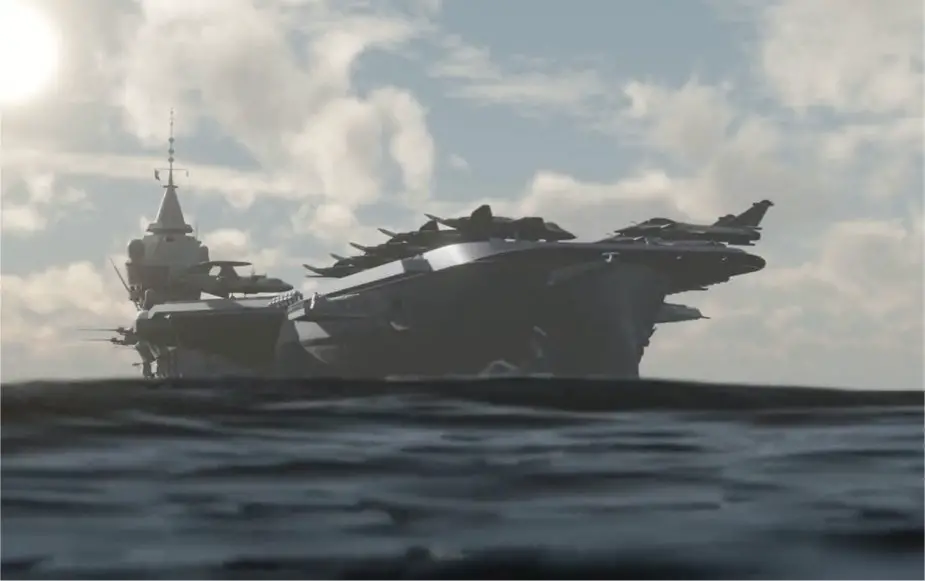Breaking news
General Atomics to equip future French aircraft carrier with EMALS.
According to information published by the U.S. DoD on August 19, 2022, General Atomics, San Diego, California, is awarded an $8,837,078 firm-fixed-price order against a previously issued basic ordering agreement for the future French Navy's aircraft carrier.
Follow Navy Recognition on Google News at this link
 Artist rendering of the future aircraft carrier PA-Ng (Picture source: Rama Neko)
Artist rendering of the future aircraft carrier PA-Ng (Picture source: Rama Neko)
This order provides for the development of a two or three launch motor subsystem, two energy storage group tailored configuration of the Electromagnetic Aircraft Launch System (EMALS) and a three wire, six energy absorber subsystem Advanced Arresting Gear System configuration that are compatible with the government of France’s future aircraft carrier and provides acceptable mission capability.
Work will be performed in San Diego, California (98.85%); and Tupelo, Mississippi (1.15%), and is expected to be completed in June 2023. Foreign Military Sales customer funds in the amount of $8,837,078 will be obligated at the time of award, none of which will expire at the end of the current fiscal year. The Naval Air Systems Command, Patuxent River, Maryland, is the contracting activity.
The Electromagnetic Aircraft Launch System (EMALS) is a type of aircraft launching system developed by General Atomics for the United States Navy. The system launches carrier-based aircraft by means of a catapult employing a linear induction motor rather than the conventional steam piston. EMALS was first installed on the lead ship of the Gerald R. Ford-class aircraft carrier, the USS Gerald R. Ford.
Its main advantage is that it accelerates aircraft more smoothly, putting less stress on their airframes. Compared to steam catapults, the EMALS also weighs less, is expected to cost less and require less maintenance, and can launch both heavier and lighter aircraft than a steam piston-driven system. It also reduces the carrier's requirement of fresh water, thus reducing the demand for energy-intensive desalination.
Developed in the 1950s, steam catapults have proven exceptionally reliable. Carriers equipped with four steam catapults have been able to use at least one of them 99.5% of the time.
However, there are a number of drawbacks. These control problems allow Nimitz-class aircraft carrier steam-powered catapults to launch heavy aircraft, but not aircraft as light as many unmanned aerial vehicles.
The EMALS uses a linear induction motor (LIM), which uses alternating current (AC) to generate magnetic fields that propel a carriage along a track to launch the aircraft.
The EMALS consists of four main elements: The linear induction motor consists of a row of stator coils with the same function as the circular stator coils in a conventional induction motor.
When energized, the motor accelerates the carriage along the track. Only the section of the coils surrounding the carriage is energized at any given time, thereby minimizing reactive losses. The EMALS's 300-foot (91 m) LIM can accelerate a 100,000-pound (45,000 kg) aircraft to 130 kn (240 km/h; 150 mph).
During a launch, the induction motor requires a large surge of electric power that exceeds what the ship's own continuous power source can provide. The EMALS energy-storage system design accommodates this by drawing power from the ship during its 45-second recharge period and storing the energy kinetically using the rotors of four disk alternators; the system then releases that energy (up to 484 MJ) in 2–3 seconds.
Each rotor delivers up to 121 MJ (34 kWh) (approximately one gasoline gallon equivalent) and can be recharged within 45 seconds of a launch; this is faster than steam catapults. A maximum-performance launch using 121 MJ of energy from each disk alternator slows the rotors from 6400 rpm to 5205 rpm.





























